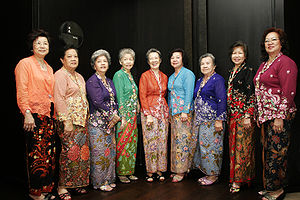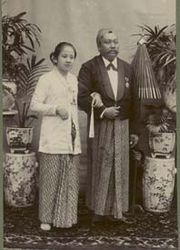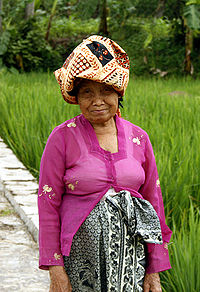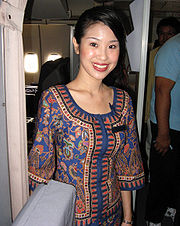
Kebaya
Encyclopedia

Women in Indonesia
The changes in Indonesian society that are affecting the roles of women in Indonesia today include increased modernization and globalization, better education, and advancing technology...
, Malaysia, Brunei
Brunei
Brunei , officially the State of Brunei Darussalam or the Nation of Brunei, the Abode of Peace , is a sovereign state located on the north coast of the island of Borneo, in Southeast Asia...
, Burma
Women in Burma
Historically, women in Burma have had a unique social status in Burmese society. According to the research made by Daw Mya Sein, Burmese women "for centuries – even before recorded history" owned a "high measure of independence" and had retained their "legal and economic rights" despite the...
, Singapore, southern Thailand
Southern Thailand
Southern Thailand is a distinct region of Thailand, connected with the Central region by the narrow Kra Isthmus.-Geography:Southern Thailand is located on the Malay Peninsula, with an area around 70,713 km², bounded to the north by Kra Isthmus as the narrowest part of the peninsula. The...
. It is sometimes made from sheer material and usually worn with a sarong
Sarong
A sarong or sarung is a large tube or length of fabric, often wrapped around the waist and worn as a kilt by men and as a skirt by women throughout much of South Asia, Southeast Asia, the Arabian Peninsula, the Horn of Africa, and on many Pacific islands. The fabric most often has woven plaid or...
or batik
Batik
Batik is a cloth that traditionally uses a manual wax-resist dyeing technique. Batik or fabrics with the traditional batik patterns are found in Indonesia, Malaysia, Japan, China, Azerbaijan, India, Sri Lanka, Egypt, Nigeria, Senegal, and Singapore.Javanese traditional batik, especially from...
kain panjang, or other traditional woven garment such as ikat
Ikat
Ikat, or Ikkat, is a dyeing technique used to pattern textiles that employs a resist dyeing process similar to tie-dye on either the warp or weft fibres....
, songket
Songket
Songket is a fabric that belongs to the brocade family of textiles of Indonesia, Malaysia, and Brunei. It is hand-woven in silk or cotton, and intricately patterned with gold or silver threads. The metallic threads stand out against the background cloth to create a shimmering effect...
with a colorful motif.
The kebaya is the national costume
National costume
Folk costume expresses an identity through costume which usually to a geographic area or a period of time in history, but can also indicate social, marital and/or religious status...
of Indonesia
Indonesia
Indonesia , officially the Republic of Indonesia , is a country in Southeast Asia and Oceania. Indonesia is an archipelago comprising approximately 13,000 islands. It has 33 provinces with over 238 million people, and is the world's fourth most populous country. Indonesia is a republic, with an...
, although it is more accurately endemic to Javanese, Sundanese
Sundanese people
The Sundanese are an ethnic group native to the western part of the Indonesian island of Java. They number approximately 31 million, and are the second most populous of all the nation's ethncities. The Sundanese are predominantly Muslim...
and Balinese
Balinese people
The Balinese population of 3.0 million live mostly on the island of Bali, making up 89% of the island's population. There are also significant populations on the island of Lombok, and in the eastern-most regions of Java The Balinese population of 3.0 million (1.5% of Indonesia's population) live...
people.
Etymology
Kebaya is inspired from ArabArabian Peninsula
The Arabian Peninsula is a land mass situated north-east of Africa. Also known as Arabia or the Arabian subcontinent, it is the world's largest peninsula and covers 3,237,500 km2...
region clothing; the Arabic
Arabic language
Arabic is a name applied to the descendants of the Classical Arabic language of the 6th century AD, used most prominently in the Quran, the Islamic Holy Book...
word abaya means clothing.
History

The name of Kebaya as a particular clothing type was noted by the Portuguese
Portuguese people
The Portuguese are a nation and ethnic group native to the country of Portugal, in the west of the Iberian peninsula of south-west Europe. Their language is Portuguese, and Roman Catholicism is the predominant religion....
when they landed in Indonesia
Indonesia
Indonesia , officially the Republic of Indonesia , is a country in Southeast Asia and Oceania. Indonesia is an archipelago comprising approximately 13,000 islands. It has 33 provinces with over 238 million people, and is the world's fourth most populous country. Indonesia is a republic, with an...
. Kebaya is associated with a type of blouse
Blouse
A blouse is a loose-fitting upper garment that was formerly worn by workmen, peasants, artists, women and children. It is typically gathered at the waist so that it hangs loosely over the wearer's body. Today, the word most commonly refers to a woman's shirt but can also refer to a man's shirt if...
worn by Indonesian women in 15th or 16th century.
Prior to 1600, kebaya on Java island were considered as a sacred clothing to be worn only by royal family
Royal family
A royal family is the extended family of a king or queen regnant. The term imperial family appropriately describes the extended family of an emperor or empress, while the terms "ducal family", "grand ducal family" or "princely family" are more appropriate to describe the relatives of a reigning...
, aristocrats
Aristocracy (class)
The aristocracy are people considered to be in the highest social class in a society which has or once had a political system of Aristocracy. Aristocrats possess hereditary titles granted by a monarch, which once granted them feudal or legal privileges, or deriving, as in Ancient Greece and India,...
(bangsawan) and minor nobility
Priyayi
Priyayi is the Dutch era class of the nobles of the Robe, as opposed to royal nobility or bangsawan or ningrat/di ningrat in Java, Indonesia's most populous island...
, in an era when peasant men and many women walked publicly bare-chested.
Slowly it naturally spread to neighbouring areas through trade, diplomacy and social interactions to Malacca
Malacca
Malacca , dubbed The Historic State or Negeri Bersejarah among locals) is the third smallest Malaysian state, after Perlis and Penang. It is located in the southern region of the Malay Peninsula, on the Straits of Malacca. It borders Negeri Sembilan to the north and the state of Johor to the south...
, Bali
Bali
Bali is an Indonesian island located in the westernmost end of the Lesser Sunda Islands, lying between Java to the west and Lombok to the east...
, Sumatra
Sumatra
Sumatra is an island in western Indonesia, westernmost of the Sunda Islands. It is the largest island entirely in Indonesia , and the sixth largest island in the world at 473,481 km2 with a population of 50,365,538...
, Borneo
Borneo
Borneo is the third largest island in the world and is located north of Java Island, Indonesia, at the geographic centre of Maritime Southeast Asia....
, Sulawesi
Sulawesi
Sulawesi is one of the four larger Sunda Islands of Indonesia and is situated between Borneo and the Maluku Islands. In Indonesia, only Sumatra, Borneo, and Papua are larger in territory, and only Java and Sumatra have larger Indonesian populations.- Etymology :The Portuguese were the first to...
and the Sultanate of Sulu and Mindanao
Mindanao
Mindanao is the second largest and easternmost island in the Philippines. It is also the name of one of the three island groups in the country, which consists of the island of Mindanao and smaller surrounding islands. The other two are Luzon and the Visayas. The island of Mindanao is called The...
Javanese kebaya as known today were noted by Raffles in 1817, as being of silk, brocade and velvet, with the central opening of the blouse fastened by brooches, rather than button and button-holes over the torso wrap kemben, the kain (and unstitched wrap fabric several metres long erroneously termed 'sarong in English (a sarung (Malaysian accent: sarong) is stitched to form a tube, like a Western dress)
After hundreds of years of regional acculturation, the garments have become highly localised expressions of ethnic culture, artistry and tailoring traditions.
The earliest photographic evidence of the kebaya as known today date from 1857 of Javanese, Peranakan and Eurasian styles.
Costume components

Safety pin
A safety pin is a simple fastening device, a variation of the regular pin which includes a simple spring mechanism and a clasp. The clasp serves two purposes: to form a closed loop thereby properly fastening the pin to whatever it is applied to, and to cover the end of the pin to protect the user...
(peniti).
The blouse is commonly semi-transparent and worn over the torso wrap or kemben. The skirt or kain is an unstitched fabric wrap around three metres long. The term sarong in English is erroneous, the sarung (Malaysian accent: sarong) is actually stitched together to form a tube, like a Western dress- the kain is unstitched, requires a helper to dress (literally wrap) the wearer and is held in place with a string (tali), then folded this string at the waist, then held with a belt (sabuk or ikat pinggang), which may hold a decorative pocket.
Varieties
There are two main varieties.The blouse, known as baju kebaya may be of two main form: the semi-transparent straighter cut blouse of the Java, Bali and the more tightly tailored Sunda kebaya and the more Islamic compatible, plainer baju kurung is a loose-fitting, knee-length long-sleeved blouse worn in the more adherent Muslim areas- including former Kingdom of Johor-Riau (now Malaysia), Sumatra and parts of coastal Java.
In Java, Bali and Sunda, the kain is commonly batik which may be from plain stamped cotton to elaborately hand-painted batik tulis embroidered silk with gold thread. In Lampung
Lampung
Lampung is a province of Indonesia. It is located on the southern tip of the island of Sumatra and borders the provinces of Bengkulu and South Sumatra. Lampung is the original home of the Lampung people, who speak a distinct language from other people in Sumatra and have their own alphabet. Its...
, the kain is the traditional tapis- an elaborate gold-thread embroidered ikat with small mica discs.
Sumatera, Flores, Lemata Timor, and other islands commonly use kain of ikat or songket.
Sumba is famous for kain decorated with lau hada: shells and beads.
During Dutch colonization
Dutch East Indies
The Dutch East Indies was a Dutch colony that became modern Indonesia following World War II. It was formed from the nationalised colonies of the Dutch East India Company, which came under the administration of the Netherlands government in 1800....
of the island, European women began wearing the less restrictive and cooler kebaya as a formal or social dress. European women wore shorter sleeve and total length cotton in prints.
The day kebaya of the Indo Eurasians was of white cotton trimmed with European handmade lace- commonly from Bruges or Holland and black silk for evening wear.
In the Malacca
Malacca
Malacca , dubbed The Historic State or Negeri Bersejarah among locals) is the third smallest Malaysian state, after Perlis and Penang. It is located in the southern region of the Malay Peninsula, on the Straits of Malacca. It borders Negeri Sembilan to the north and the state of Johor to the south...
region, a different variety of kebaya is called "nyonya kebaya" worn by those of Chinese ancestry: the Peranakan
Peranakan
Peranakan Chinese and Baba-Nyonya are terms used for the descendants of late 15th and 16th-century Chinese immigrants to the Indonesian archipelago of Nusantara during the Colonial era....
people. The Nyonya kebaya is different in its famously intricately hand-beaded shoes (kasut manek) and use of kain with Chinese motive batik or imported printed or hand-painted Chinese silks.
Political significance
The only woman present during Indonesia's Proclamation of Independence, Dutch-educated activist SK Trimurti- wore kebaya cementing it as the female dress of Nationalism.In Japanese internment camps during the Second World War
Japanese Occupation of Indonesia
The Japanese Empire occupied Indonesia, known then as the Dutch East Indies, during World War II from March 1942 until after the end of War in 1945...
, Indonesian female prisoners refused to wear the Western dress allocated them and instead wore kebaya as a display of Nationalist and racial solidarity separate from fellow Chinese, Europeans and Eurasian inmates.
The 21st of April is celebrated in Indonesia as National Kartini Day where Raden Ajeng Kartini, the female suffragist and education advocate is remembered by schoolgirls wearing traditional dress according to their region. In Java, Bali and Sunda it is the kebaya.
Kebaya as the national costume of Indonesian women were often featured by Indonesian first ladies. The wives of Sukarno
Sukarno
Sukarno, born Kusno Sosrodihardjo was the first President of Indonesia.Sukarno was the leader of his country's struggle for independence from the Netherlands and was Indonesia's first President from 1945 to 1967...
, Indonesian first president; Fatmawati Sukarno and Dewi Sukarno
Dewi Sukarno
, born , is a Japanese socialite and one of the wives of former Indonesian leader Sukarno.- Biography :Dewi Sukarno met the 57-year-old Sukarno when she was 19, when the then-Indonesian president was on a state visit to Japan. Prior to becoming Sukarno's wife, she was an art student and...
were known to wearing kebaya daily.
The Suharto-era bureaucrat wives' social organisation Dharma Wanita wears a uniform of gold kebaya, with a red sash (selendang) and stamped batik pattern on the kain unique to Dharma Wanita. The late Indonesian first lady and also a minor aristocrat Tien Suharto was a prominent advocate of the kebaya.
Former President Megawati Sukarnoputri
Megawati Sukarnoputri
In this Indonesian name, the name "Sukarnoputri" is a patronymic, not a family name, and the person should be referred to by the given name "Megawati"....
is a public champion of kebaya and wears fine red kebaya whenever possible in public forums and 2009 Presidential election debates.
Cultural rivalry between Malaysia and Indonesia has given rise to media-based spats over the true ownership of the kebaya.
Modern usage and innovations

Modern-day kebaya now incorporate modern Western tailoring innovations such as clasps, zippers and buttons- zippers being a much appreciated addition for ladies' requiring the bathroom, without requiring being literally unwrapped by a helper- to the extent the true kain is near unanimously rejected. Other modern innovations have included the blouse baju kebaya worn without the restrictive kemben, and eve the kebaya blouse worn with slacks or made of the fabric usually for the kain panjang.
The "Singapore Girl
Singapore Girl
Singapore Girl is a consistent visual advertising slogan applied to depictions of stewardesses of Singapore Airlines dressed in the distinctive "Sarong Kebaya" SIA uniform since 1972 and remains a prominent element of SIA's marketing....
" uniform worn by Singapore Airlines
Singapore Airlines
Singapore Airlines Limited is the flag carrier airline of Singapore. Singapore Airlines operates a hub at Changi Airport and has a strong presence in the Southeast Asia, East Asia, South Asia, and "Kangaroo Route" markets...
stewardesses is a rather more tight-fitting interpretation of the traditional costume by French haute couture designer Pierre Balmain
Pierre Balmain
Pierre Alexandre Claudius Balmain was a French fashion designer. Known for sophistication and elegance, he once said that "dressmaking is the architecture of movement."...
in 1972, considered an international icon. The female flight attendant of Malaysia Airlines
Malaysia Airlines
Malaysian Airline System Berhad , DBA Malaysia Airlines , is the government-owned flag carrier of Malaysia. Malaysia Airlines operates flights from its home base, Kuala Lumpur International Airport, and its eastern hub in Kota Kinabalu. It has its headquarters on the grounds of Sultan Abdul Aziz...
also featuring batik kebaya as their uniform.
The female uniform of Garuda Indonesia
Garuda Indonesia
PT Garuda Indonesia Tbk , publicly known as Garuda Indonesia, is the flag carrier of Indonesia. It is named after the mystical giant bird Garuda of Hinduism and Buddhist mythology. It is headquartered at Soekarno-Hatta International Airport in Tangerang, near Jakarta, the capital city of Indonesia...
flight attendants is more authentic modern interpretations, the kebaya is designed in simple yet classic kartini style kebaya derived from 19th century kebaya of Javanese noblewomen. The kebaya made from fire-proof cotton-polyester fabrics, with batik
Batik
Batik is a cloth that traditionally uses a manual wax-resist dyeing technique. Batik or fabrics with the traditional batik patterns are found in Indonesia, Malaysia, Japan, China, Azerbaijan, India, Sri Lanka, Egypt, Nigeria, Senegal, and Singapore.Javanese traditional batik, especially from...
sarongs in parang or lereng gondosuli motif, which also incorporate garuda
Garuda
The Garuda is a large mythical bird or bird-like creature that appears in both Hindu and Buddhist mythology.From an Indian perspective, Garuda is the Hindu name for the constellation Aquila and...
's wing motif and small dots represent jasmine
Jasmine
Jasminum , commonly known as jasmines, is a genus of shrubs and vines in the olive family . It contains around 200 species native to tropical and warm temperate regions of the Old World...
.
See also
- Culture of IndonesiaCulture of IndonesiaIndonesian culture has been shaped by long interaction between original indigenous customs and multiple foreign influences. Indonesia is central along ancient trading routes between the Far East and the Middle East, resulting in many cultural practices being strongly influenced by a multitude of...
- Culture of SingaporeCulture of SingaporeSingapore was a part of British Malaya for many centuries. It was ruled by the Sultanate of Johor. In 1819, the British came to the Island and set up a port and colony. During British rule, the port of Singapore flourished and attracted many migrants...
- Culture of MalaysiaCulture of MalaysiaThe Culture of Malaysia draws on the varied cultures of the different people of Malaysia. The first people to live in the area were indigenous tribes that still remain; they were followed by the Malays, who moved there from mainland Asia in ancient times...

